Augmented Reality (AR) is a technology that has been gaining popularity in the healthcare sector. AR is a real-world augmented experience that overlays or mixes simulated digital imagery with the real world as seen through a camera or display. This technology has various applications in healthcare, including medical training and education, surgery and treatment planning, patient-centered AR applications, diagnosis and imaging, and more.
AR has the potential to revolutionize the healthcare industry by providing healthcare professionals with real-time information and improving patient outcomes. AR is already being used in various healthcare facilities worldwide, for applications such as vein visualization, surgical visualization, and education. Recent hardware and software advances have reduced the cost of AR while significantly improving the experience for users and developers.
However, the implementation of AR in healthcare also comes with its own set of challenges and risks, such as the need for regulatory compliance, privacy concerns, and the potential for errors and misinterpretation. Despite these challenges, the future of AR in healthcare looks promising, with advancements in technology and increased adoption by healthcare providers.
Key Takeaways
- AR has various applications in healthcare, including medical training and education, surgery and treatment planning, patient-centered AR applications, diagnosis and imaging, and more.
- AR has the potential to revolutionize the healthcare industry by providing healthcare professionals with real-time information and improving patient outcomes.
- The implementation of AR in healthcare comes with its own set of challenges and risks, such as the need for regulatory compliance, privacy concerns, and the potential for errors and misinterpretation.
Evolution of AR in Healthcare
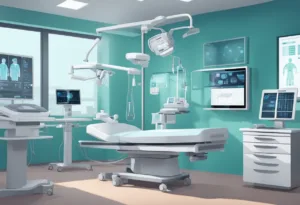
Historical Milestones
The use of augmented reality (AR) in healthcare is not a new concept. In the early 1990s, the first AR surgical navigation system was developed. Later, in 2013, Google Glass was introduced, which allowed doctors to access patient information and medical records hands-free. However, it was not until the advent of Microsoft HoloLens that the true potential of AR in healthcare was realized.
Current Trends
Today, AR technology is being used in various aspects of the medical field, including medical training and education, improved surgical precision, and transforming patient care. Medical professionals can use AR to visualize and explore the human body, diagnose and treat diseases, and simulate surgeries. The technology has also shown promise in pain management and rehabilitation.
One of the most significant advantages of AR in healthcare is the ability to provide personalized treatments to patients. With the help of artificial intelligence (AI), AR can analyze patient data and provide real-time feedback to healthcare professionals. This allows doctors to make more informed decisions and provide better care to their patients.
Another trend in AR is the development of more cost-effective hardware and software. This has made the technology more accessible to healthcare professionals and has led to increased adoption of AR in the medical field.
The evolution of AR in healthcare has been a gradual process, with significant milestones along the way. Today, the technology is being used to improve patient outcomes and provide more personalized care. As hardware and software continue to improve, the potential for AR in healthcare is limitless.
AR in Medical Training and Education
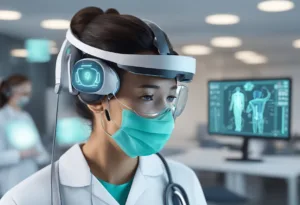
Augmented Reality (AR) is a technology that has been used to enhance medical training and education. It provides a unique learning experience that combines virtual and real-world environments. The use of AR in medical training and education has been shown to improve learning outcomes, increase retention rates, and enhance the overall learning experience.
Surgical Training
AR has been used to provide surgeons with a realistic training experience. Surgeons can use AR to simulate surgeries and practice complex procedures before performing them on real patients. This helps to reduce the risk of errors and complications during surgery. AR can also be used to provide surgeons with a better understanding of anatomy and the spatial relationships between different organs.
Medical Student Learning
AR has also been used to enhance medical student learning. Medical students can use AR to visualize complex medical concepts and procedures. AR can be used to provide students with a better understanding of anatomy and physiology. It can also be used to simulate patient encounters and provide students with a realistic learning experience.
AR can also be used to provide medical students with a better understanding of the interactions between different organs and systems. This can help to improve their diagnostic skills and increase their ability to develop treatment plans.
AR has the potential to revolutionize medical training and education. It provides a unique learning experience that combines virtual and real-world environments. The use of AR in medical training and education has been shown to improve learning outcomes, increase retention rates, and enhance the overall learning experience.
AR for Surgery and Treatment Planning
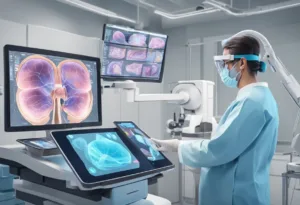
Augmented reality (AR) technology has been a game-changer in the field of surgical navigation, revolutionizing the way complex procedures are conducted and significantly improving patient outcomes. AR technology provides surgeons with a real-time, three-dimensional view of the patient’s anatomy, allowing them to more accurately plan and execute surgical procedures.
Preoperative Planning
AR technology enables surgeons to perform a thorough preoperative assessment of the patient’s anatomy. With the help of AR, surgeons can create a virtual model of the patient’s anatomy, allowing them to identify potential complications and plan the surgical procedure accordingly. This technology also allows surgeons to simulate the surgical procedure, providing them with a better understanding of the patient’s anatomy and reducing the risk of complications during the actual surgery.
In addition, AR technology can be used to create custom surgical guides and implants, which can be tailored to the specific needs of each patient. These guides and implants can be 3D printed, providing surgeons with a more accurate and precise fit during the surgical procedure.
Intraoperative Assistance
During the surgical procedure, AR technology provides surgeons with real-time guidance and assistance. With the help of AR, surgeons can overlay digital images onto the patient’s anatomy, allowing them to more accurately locate and identify structures within the body. This technology can also be used to track the position of surgical instruments in real-time, providing surgeons with more accurate feedback and reducing the risk of complications.
AR technology can also be used to provide surgeons with a more accurate view of the patient’s anatomy during minimally invasive procedures. With the help of AR, surgeons can visualize the patient’s anatomy in real-time, allowing them to more accurately navigate through the body and reduce the risk of complications.
AR technology has revolutionized the way surgical procedures are conducted and has significantly improved patient outcomes. This technology provides surgeons with a more accurate and precise view of the patient’s anatomy, allowing them to more accurately plan and execute surgical procedures. With the help of AR, surgeons can provide patients with better outcomes and a faster recovery time.
Patient-Centered AR Applications

Augmented reality (AR) has the potential to revolutionize the way healthcare providers interact with patients. Patient-centered AR applications can provide patients with a more immersive and personalized experience that can improve their understanding of their condition, treatment, and rehabilitation.
Patient Education
AR can be used to create interactive educational experiences that allow patients to visualize complex medical concepts and procedures. For example, patients with chronic conditions such as diabetes can use AR to learn about the anatomy of the human body and how their condition affects it. AR can also be used to simulate surgical procedures, allowing patients to understand what will happen during their surgery and how they can prepare for it.
Rehabilitation
AR can also be used to assist with patient rehabilitation. By providing patients with a more engaging and interactive experience, AR can help motivate patients to participate in their rehabilitation activities. For example, patients recovering from a stroke can use AR to practice their motor skills in a virtual environment, which can help them regain their physical abilities more quickly.
Patient-centered AR applications have the potential to improve patient education, treatment, and rehabilitation. By providing patients with a more immersive and personalized experience, AR can help patients better understand their condition and treatment options, which can lead to better outcomes and a higher quality of care.
AR in Diagnosis and Imaging
Augmented Reality (AR) technology has the potential to revolutionize the field of medical imaging and diagnosis. By overlaying digital information onto real-world images, AR can enhance the visualization of medical data and enable healthcare professionals to make more accurate diagnoses.
Enhanced Imaging Techniques
AR technology can be used to improve the accuracy of medical imaging techniques. By overlaying digital information onto real-world images, AR can enhance the visualization of medical data and enable healthcare professionals to make more accurate diagnoses. For example, AR can be used to create 3D models of medical images, which can be used to better visualize complex structures and identify abnormalities.
AR can also be used to improve the accuracy of medical imaging techniques such as Magnetic Resonance Imaging (MRI) and Computed Tomography (CT) scans. By overlaying digital information onto real-world images, AR can help doctors to better visualize the structure of the body and identify abnormalities that may not be visible on traditional scans.
Remote Diagnosis
AR technology can also be used to enable remote diagnosis of medical conditions. By overlaying digital information onto real-world images, AR can enable healthcare professionals to remotely diagnose medical conditions and provide treatment recommendations.
AR can be used to create interactive medical visualizations that can be used to remotely diagnose medical conditions. For example, AR can be used to create interactive 3D models of medical images that can be used to remotely diagnose medical conditions and provide treatment recommendations.
AR technology has the potential to revolutionize the field of medical imaging and diagnosis. By overlaying digital information onto real-world images, AR can enhance the visualization of medical data and enable healthcare professionals to make more accurate diagnoses. AR can also be used to enable remote diagnosis of medical conditions, which can improve access to healthcare in remote areas.
Benefits of AR in Healthcare
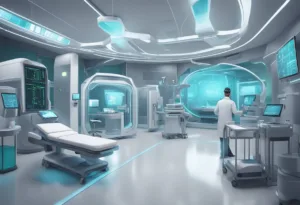
Augmented Reality (AR) is a technology that overlays digital information onto the real world, creating a mixed reality experience. In healthcare, AR has the potential to revolutionize the way medical professionals diagnose and treat patients. AR can benefit healthcare in many ways, including improving precision and safety, and enhancing patient outcomes.
Improving Precision and Safety
One of the major benefits of AR in healthcare is that it can improve precision and safety. AR can provide medical professionals with a detailed, 3D view of a patient’s anatomy, allowing them to make more accurate diagnoses and perform procedures with greater precision. This can reduce the risk of complications and improve patient outcomes.
AR can also help medical professionals identify potential risks and hazards before they become a problem. For example, AR can be used to identify areas of the body that are at risk of infection, allowing medical professionals to take preventative measures before an infection occurs.
Enhancing Patient Outcomes
Another major benefit of AR in healthcare is that it can enhance patient outcomes. AR can be used to create personalized treatment plans for patients, based on their individual needs and medical history. This can improve the effectiveness of treatment and reduce the risk of complications.
AR can also improve patient engagement and education. By providing patients with a visual representation of their condition and treatment options, AR can help patients better understand their condition and make informed decisions about their care.
AR has the potential to revolutionize the way healthcare is delivered, improving precision and safety, and enhancing patient outcomes. By harnessing the power of AR, medical professionals can provide more effective, personalized care to their patients.
Challenges and Risks of AR in Healthcare
Augmented Reality (AR) has the potential to revolutionize the healthcare industry, but it also comes with some challenges and risks. This section will discuss some of the challenges and risks of using AR in healthcare.
Privacy and Security Concerns
One of the primary concerns with AR in healthcare is the privacy and security of patient data. As AR devices become more prevalent in healthcare settings, there is an increased risk of data breaches and unauthorized access to patient information. This is particularly concerning given the sensitive nature of healthcare data.
To address these privacy risks, the FDA has issued guidelines for the use of AR in medical devices. These guidelines require that AR devices be designed with security in mind and that they comply with applicable privacy laws and regulations. It is essential for healthcare providers to be aware of these guidelines and to take steps to ensure the privacy and security of patient data.
Technical Limitations
Another challenge of using AR in healthcare is technical limitations. AR devices are still relatively new, and there are limitations to their capabilities. For example, the accuracy of AR devices may be affected by factors such as lighting conditions and the quality of the camera.
Not all AR devices are FDA-approved for use in healthcare settings. This means that healthcare providers need to be careful when selecting AR devices to ensure that they are safe and effective for use in medical settings.
Despite these challenges, AR has the potential to revolutionize the healthcare industry by providing healthcare providers with real-time, hands-free access to critical patient information. As AR technology continues to evolve, it is likely that these challenges will be addressed, and AR will become an integral part of healthcare delivery.
Regulatory Landscape for AR in Healthcare

FDA Guidelines
The use of Augmented Reality (AR) in healthcare has been gaining momentum in recent years. As a result, the US Food and Drug Administration (FDA) has issued guidelines to ensure that AR medical devices are safe and effective for patients. The FDA requires that manufacturers of AR medical devices submit their products for review and clearance before they can be marketed in the United States.
To ensure that AR medical devices meet FDA standards, the FDA requires that manufacturers provide evidence that the device is safe and effective for its intended use. This includes evidence from clinical trials, laboratory testing, and other sources. Manufacturers are also required to report any adverse events associated with their devices to the FDA through the Medical Device Reporting (MDR) system.
Global Standards
In addition to the FDA guidelines, there are global standards that manufacturers of AR medical devices must adhere to. These standards are designed to ensure that AR medical devices are safe and effective for patients worldwide. Some of the key global standards include ISO 13485 and ISO 14971.
ISO 13485 is a standard for quality management systems for medical devices. It provides a framework for manufacturers to develop and implement quality management systems that meet regulatory requirements. ISO 14971 is a standard for risk management for medical devices. It provides a framework for manufacturers to identify and manage risks associated with their devices.
Manufacturers of AR medical devices must comply with these global standards to ensure that their devices are safe and effective for patients worldwide. Compliance with these standards also helps manufacturers to gain regulatory approval in different countries around the world.
The regulatory landscape for AR in healthcare is evolving, and manufacturers of AR medical devices must adhere to FDA guidelines and global standards to ensure that their devices are safe and effective for patients. Compliance with these regulations is crucial for gaining regulatory approval and ensuring patient safety.
Future of AR in Healthcare
As the healthcare industry continues to evolve, augmented reality (AR) is poised to play a significant role in shaping the future of healthcare. AR technology is already being used in various healthcare applications such as surgery planning, intraoperative procedures, ophthalmic diagnostics, telemedicine, and medical education. The future of AR in healthcare is promising and holds great potential for emerging technologies and growth areas.
Emerging Technologies
One of the most promising emerging technologies in AR is extended reality (XR). XR includes virtual reality (VR), augmented reality (AR), and mixed reality (MR). XR technology has the potential to revolutionize the way healthcare professionals interact with patients and medical data. XR technology can be used to create immersive environments that allow healthcare professionals to visualize and interact with medical data in new and innovative ways.
Another emerging technology in AR is the use of artificial intelligence (AI) and machine learning (ML). AI and ML can be used to analyze large amounts of medical data and provide real-time feedback to healthcare professionals. AI and ML can also be used to create personalized treatment plans for patients based on their medical history and current condition.
Potential Growth Areas
There are several potential growth areas for AR in healthcare. One of the most promising growth areas is medical education. AR technology can be used to create immersive training environments that allow medical students to practice procedures and techniques in a safe and controlled environment. AR technology can also be used to provide real-time feedback and guidance to medical students during procedures.
Another potential growth area for AR in healthcare is patient care. AR technology can be used to create personalized treatment plans for patients based on their medical history and current condition. AR technology can also be used to provide patients with real-time feedback and guidance on their condition and treatment plan.
The future of AR in healthcare is promising and holds great potential for emerging technologies and growth areas. XR technology and the use of AI and ML are just a few examples of the exciting developments in AR that are set to revolutionize the healthcare industry. As AR technology continues to evolve, it will undoubtedly play an increasingly important role in shaping the future of healthcare.
AR Case Studies and Real-world Applications in Healthcare
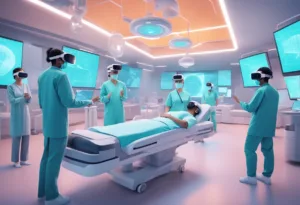
Spine Surgery
The use of Augmented Reality (AR) in spine surgery has been gaining traction in recent years. One such example is the Xvision Spine System, which provides surgeons with a 3D AR view of the patient’s spine during surgery. This technology allows for more accurate and precise placement of spinal implants, reducing the risk of complications and improving patient outcomes.
A case study published in the International Journal of Spine Surgery reported that the Xvision Spine System was successfully used in a complex spinal fusion surgery. The surgeon was able to accurately place the implants in the patient’s spine without any complications. The use of AR technology in this case allowed for a more efficient and safe surgery.
Mental Health Treatment
Augmented Reality (AR) has also been explored as a tool for mental health treatment. One such application is the use of AR to simulate anxiety-provoking situations in a controlled environment, allowing patients to confront their fears in a safe and controlled manner.
A study published in the Journal of Medical Internet Research reported that AR-based exposure therapy was effective in reducing symptoms of anxiety and depression in patients with social anxiety disorder. The study found that the use of AR technology allowed for a more immersive and realistic exposure therapy experience, leading to better treatment outcomes.
The use of Augmented Reality (AR) in healthcare has shown promising results in both case studies and real-world applications. From improving surgical precision to enhancing mental health treatment, AR technology has the potential to revolutionize the healthcare industry.
Frequently Asked Questions
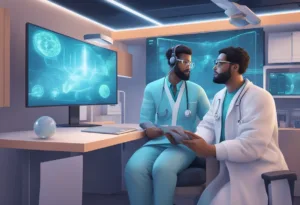
How is augmented reality transforming medical education and training?
Augmented reality (AR) technology is transforming the way medical education and training is delivered. AR allows medical students and residents to practice procedures and surgeries in a safe and controlled environment. It also allows them to visualize complex anatomy and physiology in a more interactive and engaging way. Medical professionals can now use AR to simulate surgeries and procedures, which helps to reduce the risk of errors and complications during real-life operations. In addition, AR can also be used to train healthcare professionals in emergency response scenarios, which can be difficult to simulate in real-life situations.
What are the proven benefits of using augmented reality in clinical settings?
There is growing evidence that augmented reality can improve patient outcomes in clinical settings. One of the main benefits of using AR is that it allows healthcare professionals to visualize and interact with patient data in real-time. This can help to improve diagnosis and treatment decisions. AR can also be used to enhance patient education, allowing patients to better understand their conditions and treatment options. AR can help to reduce the risk of medical errors and complications during procedures and surgeries.
Can augmented reality improve surgical outcomes, and if so, how?
Augmented reality has the potential to significantly improve surgical outcomes. By overlaying virtual images onto the real world, AR can help surgeons to visualize and navigate complex anatomy and physiology during surgeries. This can help to reduce the risk of errors and complications, and improve surgical precision. AR can also be used to enhance pre-operative planning, allowing surgeons to better plan and prepare for surgeries.
What are the challenges and limitations of implementing AR in healthcare environments?
There are several challenges and limitations associated with implementing AR in healthcare environments. One of the main challenges is the cost of implementing AR technology, which can be prohibitively expensive for some healthcare organizations. Another challenge is the need for specialized training and expertise to use AR effectively. There are concerns about the privacy and security of patient data when using AR technology.
In what ways does AR assist healthcare professionals during patient care?
AR can assist healthcare professionals in several ways during patient care. For example, AR can be used to visualize patient data in real-time, allowing healthcare professionals to make more informed decisions about diagnosis and treatment. AR can also be used to enhance patient education, allowing patients to better understand their conditions and treatment options. AR can be used to improve the accuracy and precision of medical procedures and surgeries.
How does the integration of AR and AI enhance diagnostic and treatment processes?
The integration of AR and AI has the potential to significantly enhance diagnostic and treatment processes in healthcare. By combining AR with AI, healthcare professionals can analyze large amounts of patient data in real-time, allowing for more accurate and precise diagnoses. AI can be used to develop personalized treatment plans based on patient data, which can help to improve patient outcomes. The integration of AR and AI can also help to reduce the risk of medical errors and complications during procedures and surgeries.




